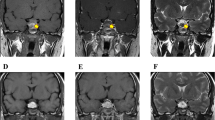Abstract
A 17-month-old boy presented with failure to thrive, polyuria, and vomiting. He had been diagnosed clinically with nephrogenic diabetes insipidus and treated by amiloride and hydrochlorothiazide combination without a satisfactory outcome at another center since 1 year of age. The diagnosis was confirmed by genetic analysis (AVPR2mutation), and the treatment was modified to include rofecoxib (a selective cyclooxygenase-2 inhibitor) in addition to hydrochlorothiazide and amiloride. This combination along with a low-salt diet resulted in a dramatic decrease in urinary free-water loss, while no side effect was noted. Because of prohibition of rofecoxib, it had to be substituted first by indomethacin and then by ibuprofen. However, both drugs were ineffective in controlling water diuresis. Thus, we had to replace these drugs by celecoxib (another selective cyclooxygenase-2 inhibitor). We conclude that the combination hydrochlorothiazide/amiloride/cyclooxygenase-2 inhibitor could be successfully used to treat congenital nephrogenic diabetes insipidus.

Similar content being viewed by others
References
Sasaki S (2004) Nephrogenic diabetes insipidus: update of genetic and clinical aspects. Nephrol Dial Transplant 19:1351–1353
Knoers NVAM, Monnens LAH (2004) Nephrogenic diabetes insipidus. In: Avner ED, Harmon WE, Niaudet P (eds) Pediatric Nephrology, 5th edn. Lippincott, Philadelphia, pp 777–787
Wildin RS, Cogdell DE (1999). Clinical utility of direct mutation testing for congenital nephrogenic diabetes insipidus in families. Pediatrics 103:632–639
Dell K, MacRae, Avner DA (2004) Nephrogenic diabetes insipidus. In: Behrman RE, Kliegman RM, Jenson HB (eds) Nelson textbook of pediatrics, 17th edn. Elsevier, Philadelphia, pp 1762–1763
Vargas PR, Forestier L, Niaudet P (1997) Mutations in the vasopressin V2 receptor and aquaporin-2 genes in 12 families with congenital nephrogenic diabetes insipidus. J Am Soc Nephrol 8:1855–1862
Janjua NR, Jonassen TEN, Langhoff S, Thomsen K, Christensen S (2001) Role of sodium depletion in acute antidiuretic effect of bendroflumethiazide in rats with nephrogenic diabetes insipidus. J Pharmacol Exp Ther 299:307–313
Magaldi AJ (2000) New insights into the paradoxical effect of thiazides in diabetes insipidus therapy. Nephrol Dial Transplant 15:1903–1905
Kim GH, Lee JW, Oh YK, Chang HR, Joo KW, Na KY, Earm JH, Knepper MA, Han JS (2004) Antidiuretic effect of hydrochlorothiazide in lithium-induced nephrogenic diabetes insipidus is associated with upregulation of aquaporin-2, Na-Cl cotransporter, and epithelial sodium channel. J Am Soc Nephrol 15:2836–2843
Kirchlechner V, Koller DY, Seidl R (1999) Treatment of nephrogenic diabetes insipidus with hydrochlorothiazide and amiloride. Arch Dis Child 80:548–552
Rascher W, Rosendahl W, Henrichs IA, Maier R, Seyberth HR (1987) Congenital nephrogenic diabetes insipidus: vasopressin and prostaglandin in response to treatment with hydrochlorothiazide and indomethacin. Pediatr Nephrol 1:485–490
Handler JS (1981) Vasopressin-prostaglandin interactions in the regulation of epithelial cells’ permeability to water. Kidney Int 19:831–838
Scharschmidt LA, Dunn MJ (1983) Prostaglandin synthesis by rat glomerular mesangial cells in culture. Effects of angiotensin II and arginine vasopressin. J Clin Invest 71:1756–1764
Hochberg Z, Even L, Danon A (1998) Amelioration of polyuria in nephrogenic diabetes insipidus due to aquaporin-2 deficiency. Clin Endocrinol (Oxf) 49:39–44
Stoff JS, Rosa RM, Silva P, Epstein FH (1981) Indomethacin impairs water diuresis in the DI rat: Role of prostaglandins independent of ADH. Am J Physiol 241:F231–F237
Kim SW, Kim JW, Choi KC, Ma SK, Oh Y, Jung JY, Kim J, Lee J (2004) Indomethacin enhances shuttling of aquaporin-2 despite decreased abundance in rat kidney. J Am Soc Nephrol 15:2998–3005
Pattaragarn A, Alon US (2003) Treatment of congenital nephrogenic diabetes insipidus by hydrochlorothiazide and cyclooxygenase-2 inhibitor. Pediatr Nephrol 18:1073–1076
Gross JM, Dwyer JE, Knox FG (1999) Natriuretic response to increased pressure is preserved with COX-2 inhibitors. Hypertension 34:1163–1167
DeMaria AN, Weir MR (2003) Coxibs—beyond the GI tract: renal and cardiovascular issues. J Pain Symptom Manage 25 [Suppl 2]: S41–S49
Libber S, Harrison H, Spector D (1986) Treatment of nephrogenic diabetes insipidus with prostaglandin synthesis inhibitors. J Pediatr 108:305–311
Hooper L, Brown TJ, Elliott R, Payne K, Roberts C, Symmons D (2004) The effectiveness of five strategies for the prevention of gastrointestinal toxicity induced by non-steroidal anti-inflammatory drugs: systematic review. BMJ 329:948–952
Acknowledgement
We thank Professor Nine Knoers, University Medical Centre Nijmegen, Department of Human Genetics, the Netherlands, for the genetic analyses.
Author information
Authors and Affiliations
Corresponding author
Rights and permissions
About this article
Cite this article
Soylu, A., Kasap, B., Öğün, N. et al. Efficacy of COX-2 inhibitors in a case of congenital nephrogenic diabetes insipidus. Pediatr Nephrol 20, 1814–1817 (2005). https://doi.org/10.1007/s00467-005-2057-8
Received:
Revised:
Accepted:
Published:
Issue Date:
DOI: https://doi.org/10.1007/s00467-005-2057-8




